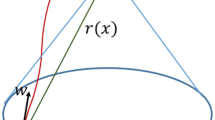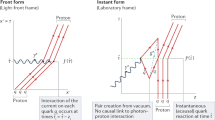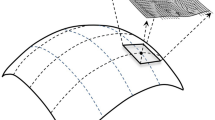Abstract
1. The loss of connexion by general invariance. The essential physical entities are mathematically described as invariants, vectors, tensors. That comes from the isotropy and homogeneity of space in Euclidean geometry—or from the pseudo-isotropy of space-time, in the Restricted Theory of Relativity. When the latter is replaced by the idea of general invariance, that is, by regarding the three space-co-ordinates and the time only as continuous labels of the world points, which labels may equivalently be replaced by any quadruplet of continuous functions of themselves, the notion of vector, or tensor subsists, but any such entity is now necessarily bound to a given world-point, it is 'a tensor at P'. For example, the displacement-vector, dxk/, leading from a world-point P with co-ordinates xk (that is, x1 x2, x3, x4) to a neighbouring point Q with co-ordinates xk + dxk, is the prototype of a contravariant vector Ak at P. If you change the labels (that is to say, if you execute a general transformation of the frame) the Ak transform by definition as the dxk thus*:
This is a preview of subscription content, access via your institution
Access options
Subscribe to this journal
Receive 51 print issues and online access
$199.00 per year
only $3.90 per issue
Buy this article
- Purchase on Springer Link
- Instant access to full article PDF
Prices may be subject to local taxes which are calculated during checkout
Similar content being viewed by others
References
Einstein, A., Ann. Phys., 49, 769 (1916).
Weyl, H.,"Raum, Zeit, Materie" (Berlin: Springer; 4th ed., 1918–20); translated by H. L. Brose (London: Methuen, 1922).
Eddington, A. S., "The Mathematical Theory of Relativity" (Cambridge, University Press, 3rd ed., 1923–30, which includes full reports on Weyl (ref. 2) and Einstein (ref. 4)).
Einstein, A., Site. Ber. d. Preuss. Akad., 32, 76, 137 (1923).
Einstein, A., Site. Ber. d. Preuss. Akad., 414 (1925).
Schroedinger, E., Proc. Roy. Irish Acad., A, 49, 135 (1943).
Schroedinger, E., Proc. Roy. Irish Acad., A, 49, 43 (1943). Three more papers, read to the Royal Irish Academy during 1943, in the Press.
Born, M., Proc. Roy. Soc., A, 143, 410 (1934). Born, M., and Infeld, L., Proc. Roy. Soc., A, 144, 425 (1934). Schroedinger, E., Proc. Roy. Irish Acad., A, 47, 77 (1942); 48, 91 (1942). McConnell, James, Proc. Roy. Irish Acad., A, 49, 149 (1943).
Author information
Authors and Affiliations
Rights and permissions
About this article
Cite this article
SCHROEDINGER, E. The Affine Connexion in Physical Field Theories. Nature 153, 572–575 (1944). https://doi.org/10.1038/153572a0
Issue Date:
DOI: https://doi.org/10.1038/153572a0
This article is cited by
-
An axiomatic criticism of unified field theories—II
Il Nuovo Cimento (1954)
-
The Point-Charge in the Non-symmetric Field Theory
Nature (1951)
-
The Fitzgerald Contraction as the Origin of our Experience of Time and its Lapse Rate
Nature (1945)
-
Unification of the Physical Fields
Nature (1945)
-
Gravitation, Electromagnetism, and Quantum Theory
Nature (1944)
Comments
By submitting a comment you agree to abide by our Terms and Community Guidelines. If you find something abusive or that does not comply with our terms or guidelines please flag it as inappropriate.



